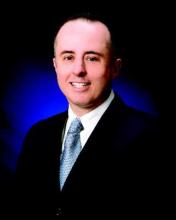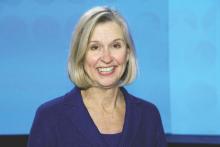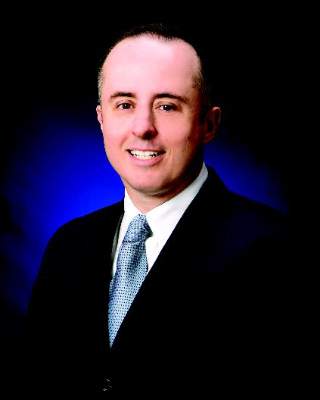User login
This has been an extraordinary year for CHEST, particularly in the core area of clinical education. In the past fiscal year, we exceeded our educational goals. We set out to reach 10,000 learners through educational programming including live courses and conferences, and online activities; in the end, we served 15,547.
Other goals accomplished include demonstrating a significant increase in average learner knowledge acquisition and procedural skills improvement; identifying top priorities for online offerings and delivering five stand-alone online modules that can serve as a point of entry to wider audiences; recording professional attendance at CHEST 2015 of 5,149 people; offering online training for guideline development and the panelists engaged in CHEST guidelines; achieving an attendance at CHEST World Congress in Shanghai of 2,089; and working with leading Chinese medical societies to see the China-CHEST Pulmonary and Critical Care Medicine Fellowship Program formally adopted by the government in China as one of the four first-ever subspecialty training programs to be implemented nationwide.
This is a lot!
These accomplishments depend on intense work and collaboration between our incredibly talented faculty and volunteers from among CHEST membership and CHEST’s amazing professional staff of 105 employees, of which 28 are dedicated full time to the development and delivery of education and best practices. Through this partnership, we continue to meet CHEST’s mission: To champion the prevention, diagnosis, and treatment of chest diseases through education, communication, and research.
Without these dedicated women and men, CHEST would be utterly unable to complete its mission. Our faculty work in a vast array of opportunities, including writing questions for SEEK, serving as a content expert for guidelines, proposing and delivering sessions at CHEST, running Board Review courses, recording videos, facilitating hands-on simulation sessions, and more. While intrinsically gratifying, there are many difficult elements to such work, requiring commitment that begins long before the delivery of an event or the launch of a new activity. Reviewing existing literature and knowledge on a topic to determine whether an activity will meet the needs of our membership; coming up with valid learning objectives; generating just the right multiple choice questions and other assessments to measure our success at helping learners reach those objectives; peer reviewing content to ensure we’re teaching to the latest science and established best practices; and then measuring learner outcomes – these elements put the “state of the art” into CHEST’s internationally recognized state-of-the-art educational program.
To achieve our mission, we have been asking CHEST’s valiant and dedicated volunteers to do more than ever before, and some of what we have asked them to do has been frustrating, tedious, and less than rewarding. The reasons for this are many, including the imperfect technology platforms we’ve asked our volunteers to use; the disconnect between the educational goals we have set and the implementation of the clear processes, communication, and on-boarding of staff required to support them; and the lag of recognition proportionate to the nature of these new asks.
So, how do we show our member-faculty that they are our most important resource? Recently, we have had internal discussions about how to acknowledge the priceless contributions made by our faculty volunteers. To that end, CHEST staff and volunteer leadership have developed a Faculty & Volunteer Treatment Action Plan, recently approved by the CHEST Board of Regents. This is part of our comprehensive “six F’s” plan:
Formal recognition and rewards. Recognition and rewards are different – but both important. Recognition is expressing gratitude for an expected job that was well done and includes a formal thank-you. Rewards are additional, tangible benefits for exceptional services. We now have enhanced guidelines for travel, honoraria, and amenities for our volunteer faculty. Also of note, two new awards will be bestowed annually beginning at CHEST 2017 Los Angeles – the Early Career Clinician Educator Award and the Master Clinician Educator Award. These are some additional ways we will more appropriately highlight the people who have helped make us CHEST, the leader in clinical education in chest medicine.
Feedback. In addition to learner satisfaction data, CHEST provides an unprecedented level of learner outcomes data to our faculty. We are even introducing a new peer-review of teaching (PRT) program so faculty can get even more feedback from expert colleagues.
Faculty Development. As an education-focused organization, training and development plays a foundational role. We are working to develop a comprehensive clinician educator program that will grow our bench of faculty. A newly launched database will more proactively track and match interested members with teaching opportunities within the organization.
Face Time. Easy access to leadership and staff is important. We are implementing staff training that will better position all CHEST employees to more effectively facilitate and support the work we ask of our faculty. On another front, we are engaged in identifying new, user-friendly systems for session submission, conflict of interest disclosure, and review, as well as developing content.
Food. It is a simple but well-established fact that having a stocked lounge area for busy faculty on the run between teaching sessions enhances efficiency, communication, camaraderie, and overall morale.
Fun. The fun of discovering better ways to take care of our patients, be it from the teacher or learner perspective, in an engaging, effective learning environment is and always has been at the center of what we do.
CHEST’s volunteer leaders, in service to their peers, the field, and the organization, have risen to many challenges over and over again. We realize we need to do a better job of rewarding and recognizing their irreplaceable contributions. The above initiatives, and others, we hope, will help demonstrate to our most precious resource, our member-faculty, that we truly value and appreciate their invaluable contributions on behalf of CHEST. Stay tuned and stay with us.
This has been an extraordinary year for CHEST, particularly in the core area of clinical education. In the past fiscal year, we exceeded our educational goals. We set out to reach 10,000 learners through educational programming including live courses and conferences, and online activities; in the end, we served 15,547.
Other goals accomplished include demonstrating a significant increase in average learner knowledge acquisition and procedural skills improvement; identifying top priorities for online offerings and delivering five stand-alone online modules that can serve as a point of entry to wider audiences; recording professional attendance at CHEST 2015 of 5,149 people; offering online training for guideline development and the panelists engaged in CHEST guidelines; achieving an attendance at CHEST World Congress in Shanghai of 2,089; and working with leading Chinese medical societies to see the China-CHEST Pulmonary and Critical Care Medicine Fellowship Program formally adopted by the government in China as one of the four first-ever subspecialty training programs to be implemented nationwide.
This is a lot!
These accomplishments depend on intense work and collaboration between our incredibly talented faculty and volunteers from among CHEST membership and CHEST’s amazing professional staff of 105 employees, of which 28 are dedicated full time to the development and delivery of education and best practices. Through this partnership, we continue to meet CHEST’s mission: To champion the prevention, diagnosis, and treatment of chest diseases through education, communication, and research.
Without these dedicated women and men, CHEST would be utterly unable to complete its mission. Our faculty work in a vast array of opportunities, including writing questions for SEEK, serving as a content expert for guidelines, proposing and delivering sessions at CHEST, running Board Review courses, recording videos, facilitating hands-on simulation sessions, and more. While intrinsically gratifying, there are many difficult elements to such work, requiring commitment that begins long before the delivery of an event or the launch of a new activity. Reviewing existing literature and knowledge on a topic to determine whether an activity will meet the needs of our membership; coming up with valid learning objectives; generating just the right multiple choice questions and other assessments to measure our success at helping learners reach those objectives; peer reviewing content to ensure we’re teaching to the latest science and established best practices; and then measuring learner outcomes – these elements put the “state of the art” into CHEST’s internationally recognized state-of-the-art educational program.
To achieve our mission, we have been asking CHEST’s valiant and dedicated volunteers to do more than ever before, and some of what we have asked them to do has been frustrating, tedious, and less than rewarding. The reasons for this are many, including the imperfect technology platforms we’ve asked our volunteers to use; the disconnect between the educational goals we have set and the implementation of the clear processes, communication, and on-boarding of staff required to support them; and the lag of recognition proportionate to the nature of these new asks.
So, how do we show our member-faculty that they are our most important resource? Recently, we have had internal discussions about how to acknowledge the priceless contributions made by our faculty volunteers. To that end, CHEST staff and volunteer leadership have developed a Faculty & Volunteer Treatment Action Plan, recently approved by the CHEST Board of Regents. This is part of our comprehensive “six F’s” plan:
Formal recognition and rewards. Recognition and rewards are different – but both important. Recognition is expressing gratitude for an expected job that was well done and includes a formal thank-you. Rewards are additional, tangible benefits for exceptional services. We now have enhanced guidelines for travel, honoraria, and amenities for our volunteer faculty. Also of note, two new awards will be bestowed annually beginning at CHEST 2017 Los Angeles – the Early Career Clinician Educator Award and the Master Clinician Educator Award. These are some additional ways we will more appropriately highlight the people who have helped make us CHEST, the leader in clinical education in chest medicine.
Feedback. In addition to learner satisfaction data, CHEST provides an unprecedented level of learner outcomes data to our faculty. We are even introducing a new peer-review of teaching (PRT) program so faculty can get even more feedback from expert colleagues.
Faculty Development. As an education-focused organization, training and development plays a foundational role. We are working to develop a comprehensive clinician educator program that will grow our bench of faculty. A newly launched database will more proactively track and match interested members with teaching opportunities within the organization.
Face Time. Easy access to leadership and staff is important. We are implementing staff training that will better position all CHEST employees to more effectively facilitate and support the work we ask of our faculty. On another front, we are engaged in identifying new, user-friendly systems for session submission, conflict of interest disclosure, and review, as well as developing content.
Food. It is a simple but well-established fact that having a stocked lounge area for busy faculty on the run between teaching sessions enhances efficiency, communication, camaraderie, and overall morale.
Fun. The fun of discovering better ways to take care of our patients, be it from the teacher or learner perspective, in an engaging, effective learning environment is and always has been at the center of what we do.
CHEST’s volunteer leaders, in service to their peers, the field, and the organization, have risen to many challenges over and over again. We realize we need to do a better job of rewarding and recognizing their irreplaceable contributions. The above initiatives, and others, we hope, will help demonstrate to our most precious resource, our member-faculty, that we truly value and appreciate their invaluable contributions on behalf of CHEST. Stay tuned and stay with us.
This has been an extraordinary year for CHEST, particularly in the core area of clinical education. In the past fiscal year, we exceeded our educational goals. We set out to reach 10,000 learners through educational programming including live courses and conferences, and online activities; in the end, we served 15,547.
Other goals accomplished include demonstrating a significant increase in average learner knowledge acquisition and procedural skills improvement; identifying top priorities for online offerings and delivering five stand-alone online modules that can serve as a point of entry to wider audiences; recording professional attendance at CHEST 2015 of 5,149 people; offering online training for guideline development and the panelists engaged in CHEST guidelines; achieving an attendance at CHEST World Congress in Shanghai of 2,089; and working with leading Chinese medical societies to see the China-CHEST Pulmonary and Critical Care Medicine Fellowship Program formally adopted by the government in China as one of the four first-ever subspecialty training programs to be implemented nationwide.
This is a lot!
These accomplishments depend on intense work and collaboration between our incredibly talented faculty and volunteers from among CHEST membership and CHEST’s amazing professional staff of 105 employees, of which 28 are dedicated full time to the development and delivery of education and best practices. Through this partnership, we continue to meet CHEST’s mission: To champion the prevention, diagnosis, and treatment of chest diseases through education, communication, and research.
Without these dedicated women and men, CHEST would be utterly unable to complete its mission. Our faculty work in a vast array of opportunities, including writing questions for SEEK, serving as a content expert for guidelines, proposing and delivering sessions at CHEST, running Board Review courses, recording videos, facilitating hands-on simulation sessions, and more. While intrinsically gratifying, there are many difficult elements to such work, requiring commitment that begins long before the delivery of an event or the launch of a new activity. Reviewing existing literature and knowledge on a topic to determine whether an activity will meet the needs of our membership; coming up with valid learning objectives; generating just the right multiple choice questions and other assessments to measure our success at helping learners reach those objectives; peer reviewing content to ensure we’re teaching to the latest science and established best practices; and then measuring learner outcomes – these elements put the “state of the art” into CHEST’s internationally recognized state-of-the-art educational program.
To achieve our mission, we have been asking CHEST’s valiant and dedicated volunteers to do more than ever before, and some of what we have asked them to do has been frustrating, tedious, and less than rewarding. The reasons for this are many, including the imperfect technology platforms we’ve asked our volunteers to use; the disconnect between the educational goals we have set and the implementation of the clear processes, communication, and on-boarding of staff required to support them; and the lag of recognition proportionate to the nature of these new asks.
So, how do we show our member-faculty that they are our most important resource? Recently, we have had internal discussions about how to acknowledge the priceless contributions made by our faculty volunteers. To that end, CHEST staff and volunteer leadership have developed a Faculty & Volunteer Treatment Action Plan, recently approved by the CHEST Board of Regents. This is part of our comprehensive “six F’s” plan:
Formal recognition and rewards. Recognition and rewards are different – but both important. Recognition is expressing gratitude for an expected job that was well done and includes a formal thank-you. Rewards are additional, tangible benefits for exceptional services. We now have enhanced guidelines for travel, honoraria, and amenities for our volunteer faculty. Also of note, two new awards will be bestowed annually beginning at CHEST 2017 Los Angeles – the Early Career Clinician Educator Award and the Master Clinician Educator Award. These are some additional ways we will more appropriately highlight the people who have helped make us CHEST, the leader in clinical education in chest medicine.
Feedback. In addition to learner satisfaction data, CHEST provides an unprecedented level of learner outcomes data to our faculty. We are even introducing a new peer-review of teaching (PRT) program so faculty can get even more feedback from expert colleagues.
Faculty Development. As an education-focused organization, training and development plays a foundational role. We are working to develop a comprehensive clinician educator program that will grow our bench of faculty. A newly launched database will more proactively track and match interested members with teaching opportunities within the organization.
Face Time. Easy access to leadership and staff is important. We are implementing staff training that will better position all CHEST employees to more effectively facilitate and support the work we ask of our faculty. On another front, we are engaged in identifying new, user-friendly systems for session submission, conflict of interest disclosure, and review, as well as developing content.
Food. It is a simple but well-established fact that having a stocked lounge area for busy faculty on the run between teaching sessions enhances efficiency, communication, camaraderie, and overall morale.
Fun. The fun of discovering better ways to take care of our patients, be it from the teacher or learner perspective, in an engaging, effective learning environment is and always has been at the center of what we do.
CHEST’s volunteer leaders, in service to their peers, the field, and the organization, have risen to many challenges over and over again. We realize we need to do a better job of rewarding and recognizing their irreplaceable contributions. The above initiatives, and others, we hope, will help demonstrate to our most precious resource, our member-faculty, that we truly value and appreciate their invaluable contributions on behalf of CHEST. Stay tuned and stay with us.



